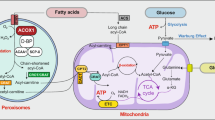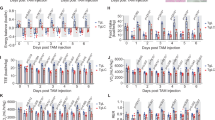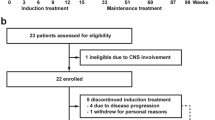Abstract
Chronic lymphocytic leukemia (CLL) cells with aggressive clinical properties express lipoprotein lipase (LPL), which generates activating ligands for the nuclear receptor peroxisome proliferator activated receptor (PPAR)α and allows fatty acids to be used as fuel. However, the role of PPARα in CLL is unclear. PPARα was found to be expressed by circulating CLL cells and highly associated with advanced stage disease. Consistent with this observation, palmitate oxidation rates in circulating CLL cells were similar to more conventional fat-burning cells such as muscle. Transgenic expression of PPARα in CD5+ Daudi cells increased both their expression of immunosuppressive factors (that is, interleukin (IL)10 and phospho-STAT3) and resistance to metabolic and cytotoxic stressors. In contrast, marked downregulation of PPARα expression accompanied immunogenic death of proliferating CLL cells. The PPARα antagonist MK886 killed circulating CLL cells directly, caused proliferating CLL cells to enter an immunogenic death pathway and cleared CLL xenografts from immunodeficient mice. These results suggest that PPARα is a biological mediator of CLL and MK886 is a clinically relevant agent with activity against CLL.
This is a preview of subscription content, access via your institution
Access options
Subscribe to this journal
Receive 12 print issues and online access
$259.00 per year
only $21.58 per issue
Buy this article
- Purchase on Springer Link
- Instant access to full article PDF
Prices may be subject to local taxes which are calculated during checkout





Similar content being viewed by others
References
Advani RH, Buggy JJ, Sharman JP, Smith SM, Boyd TE, Grant B et al. Bruton tyrosine kinase inhibitor ibrutinib (PCI-32765) has significant activity in patients with relapsed/refractory B-cell malignancies. J Clin Oncol 2012, e-pub ahead of print 22 October 2012.
Zenz T, Gribben JG, Hallek M, Döhner H, Keating MJ, Stilgenbauer S . Risk categories and refractory CLL in the era of chemoimmunotherapy. Blood 2012; 119: 4101–4107.
Rosenwald A, Alizadeh AA, Widhopf G, Simon R, Davis RE, Yu X et al. Relation of gene expression phenotype to immunoglobulin mutation genotype in B cell chronic lymphocytic leukemia. J Exp Med 2001; 194: 1639–1647.
Ruby MA, Goldenson B, Orasanu G, Johnston TP, Plutzky J, Krauss RM . VLDL hydrolysis by LPL activates PPAR-alpha through generation of unbound fatty acids. J Lipid Res 2010; 51: 2275–2281.
DeBerardinis RJ, Lum JJ, Hatzivassiliou G, Thompson CB . The biology of cancer: metabolic reprogramming fuels cell growth and proliferation. Cell Metab 2008; 7: 11–20.
Cheong H, Lu C, Lindsten T, Thompson CB . Therapeutic targets in cancer cell metabolism and autophagy. Nat Biotechnol 2012; 30: 671–678.
Samudio I, Harmancey R, Fiegl M, Kantarjian H, Konopleva M, Korchin B et al. Pharmacologic inhibition of fatty acid oxidation sensitizes human leukemia cells to apoptosis induction. J Clin Invest 2010; 120: 142–156.
Harmon GS, Lam MT, Glass CK . PPARs and lipid ligands in inflammation and metabolism. Chem Rev 2011; 111: 6321–6340.
Bluemn EG, Nelson PS . The androgen/androgen receptor axis in prostate cancer. Curr Opin Oncol 2012; 24: 251–257.
de Jong EM, van Vlijmen IM, Scholte JC, Buntinx A, Friedman B, Tanaka W et al. Clinical and biochemical effects of an oral leukotriene biosynthesis inhibitor (MK886) in psoriasis. Skin Pharmacol 1991; 4: 278–285.
Kehrer J, Biswal S, La E, Thuillier P, Datta K, Fischer S et al. Inhibition of PPARalpha by MK886. Biochem J 2001; 356: 899–906.
Hallek M, Cheson BD, Catovsky D, Caligaris-Cappio F, Dighiero G, Döhner H et al. International workshop on chronic lymphocytic leukemia. Guidelines for the diagnosis and treatment of chronic lymphocytic leukemia. Blood 2008; 111: 5446–5456.
Gitelson E, Hammond C, Mena J, Lorenzo M, Buckstein R, Berinstein NL et al. Chronic lymphocytic leukemia-reactive T cells during tumor progression and after oxidized autologous tumor cell vaccines. Clin Can Res 2003; 9: 1656–1665.
Wong KK, Brenneman F, Chesney A, Spaner DE, Gorczynski RM . Soluble CD200 Is Critical to Engraft Chronic Lymphocytic Leukemia Cells in Immunocompromised Mice. Cancer Res 2012; 72: 4931–4943.
Bain G, King CD, Rewolinski M, Schaab K, Santini AM, Shapiro D et al. Pharmacodynamics and pharmacokinetics of AM103, a novel inhibitor of 5 lipoxygenase-activating protein (FLAP). Clin Pharmacol Ther 2010; 87: 437–444.
Tomic J, White D, Shi Y, Mena J, Hammond C, He L et al. Sensitization of IL-2 signaling through TLR-7 enhances B lymphoma cell immunogenicity. J Immunol 2006; 176: 3830–3839.
Shaha S, Tomic J, Shi Y, Pham T, Mero P, White D et al. Prolonging microtubule dysruption enhances the immunogenicity of CLL cells. Clin Exp Immunol 2009; 158: 186–198.
Pimenta AS, Gaidhu MP, Habib S, So M, Fediuc S, Mirpourian M et al. Prolonged exposure to palmitate impairs fatty acid oxidation despite activation of AMP-activated protein kinase in skeletal muscle cells. J Cell Physiol 2008; 217: 478–485.
Gary-Gouy H, Sainz-Perez A, Marteau JB, Marfaing-Koka A, Delic J, Merle-Beral H et al. Natural phosphorylation of CD5 in CLL B cells and analysis of CD5-regulated genes in a B cell line suggest a role for CD5 in malignant phenotype. J Immunol 2007; 179: 4335–4344.
Gary-Gouy H, Harriague J, Bismuth G, Platzer C, Schmitt C, Dalloul AH . Human CD5 promotes B-cell survival through stimulation of autocrine IL-10 production. Blood 2002; 100: 4537–4543.
Fayad L, Keating MJ, Reuben JM, O'Brien S, Lee BN, Lerner S et al. Interleukin-6 and interleukin-10 levels in CLL: correlation with phenotypic characteristics and outcome. Blood 2001; 97: 256–63.
Bertilaccio MT, Scielzo C, Simonetti G, Ponzoni M, Apollonio B, Fazi C et al. A novel Rag2-/-gammac-/--xenograft model of human CLL. Blood 2010; 115: 1605–1609.
Joly E, Roduit R, Peyot ML, Habinowski SA, Ruderman NB, Witters LA et al. Glucose represses PPARalpha gene expression via AMPK but not via p38 mitogen-activated protein kinase in the pancreatic beta-cell. J Diabetes 2009; 1: 263–272.
Schulze A, Downward J . Flicking the Warburg switch-tyrosine phosphorylation of pyruvate dehydrogenase kinase regulates mitochondrial activity in cancer cells. Mol Cell 2011; 44: 846–848.
Li YJ, Zhao X, Vecchiarelli-Federico LM, Li Y, Datti A, Cheng Y et al. Drug mediated inhibition of Fli-1 for the treatment of leukemia. Blood Cancer J 2012; 2: e54.
Zenz T, Mertens D, Kuppers R, Dohner H, Stilgenbauer S . From pathogenesis to treatment of chronic lymphocytic leukaemia. Nat Rev Cancer 2010; 10: 37–50.
Tomic J, Lichty B, Spaner DE . Aberrant interferon-signaling is associated with aggressive chronic lymphocytic leukemia. Blood 2011; 117: 2668–2680.
Herishanu Y, Pérez-Galán P, Liu D, Biancotto A, Pittaluga S, Vire B et al. The lymph node microenvironment promotes B-cell receptor signaling, NF-kappaB activation, and tumor proliferation in chronic lymphocytic leukemia. Blood 2011; 117: 563–574.
Green DR, Ferguson T, Zitvogel L, Kroemer G . Immunogenic and tolerogenic cell death. Nat Rev Immunol 2009; 9: 353–363.
Sheikh NA, Jones LA . CD54 is a surrogate marker of antigen presenting cell activation. Cancer Immunol Immunother 2008; 57: 1381–1390.
Karam M, Novak L, Cyriac J, Ali A, Nazeer T, Nugent F . Role of fluorine-18 fluoro deoxyglucose positron emission tomography scan in the evaluation and follow-up of patients with low-grade lymphomas. Cancer 2006; 107: 175–183.
Lemberger T, Saladin R, Vázquez M, Assimacopoulos F, Staels B, Desvergne B et al. Expression of the peroxisome proliferator-activated receptor alpha gene is stimulated by stress and follows a diurnal rhythm. J Biol Chem 1996; 271: 1764–1769.
Diehl CJ, Barish GD, Downes M, Chou MY, Heinz S, Glass CK et al. Research resource: comparative nuclear receptor atlas: basal and activated peritoneal B-1 and B-2 cells. Mol Endocrinol 2011; 25: 529–545.
Michalek RD, Gerriets VA, Jacobs SR, Macintyre AN, MacIver NJ, Mason EF et al. Cutting edge: distinct glycolytic and lipid oxidative metabolic programs are essential for effector and regulatory CD4+ T cell subsets. J Immunol 2011; 186: 3299–3303.
Harper ME, Antoniou A, Villalobos-Menuey E, Russo A, Trauger R, Vendemelio M et al. Characterization of a novel metabolic strategy used by drug-resistant tumor cells. FASEB J 2002; 16: 1550–1557.
Panigrahy D, Kaipainen A, Huang S, Butterfield C, Barnés C, Fannon M et al. PPARalpha deficiency in inflammatory cells suppresses tumor growth. PLoS One 2007; 2: e260.
Acknowledgements
This work was supported by grants from the Canadian Institutes of Health Research (CIHR) (No.190633) and the Leukemia and Lymphoma Society of Canada (to DS). We thank Peppi Prasit (Inception Sciences, San Diego, CA) for MK886, AM103 and pharmacokinetic analyses.
Author information
Authors and Affiliations
Corresponding author
Ethics declarations
Competing interests
The authors declare no conflict of interest.
Additional information
Supplementary Information accompanies the paper on the Leukemia website
Supplementary information
Rights and permissions
About this article
Cite this article
Spaner, D., Lee, E., Shi, Y. et al. PPAR-alpha is a therapeutic target for chronic lymphocytic leukemia. Leukemia 27, 1090–1099 (2013). https://doi.org/10.1038/leu.2012.329
Received:
Accepted:
Published:
Issue Date:
DOI: https://doi.org/10.1038/leu.2012.329
Keywords
This article is cited by
-
HELQ and EGR3 expression correlate with IGHV mutation status and prognosis in chronic lymphocytic leukemia
Journal of Translational Medicine (2021)
-
Ibrutinib reprograms the glucocorticoid receptor in chronic lymphocytic leukemia cells
Leukemia (2019)
-
PPAR-delta modulates membrane cholesterol and cytokine signaling in malignant B cells
Leukemia (2018)
-
Plasma metabonomics investigation reveals involvement of fatty acid oxidation in hematotoxicity in Chinese benzene-exposed workers with low white blood cell count
Environmental Science and Pollution Research (2018)
-
PPAR-delta promotes survival of chronic lymphocytic leukemia cells in energetically unfavorable conditions
Leukemia (2017)



